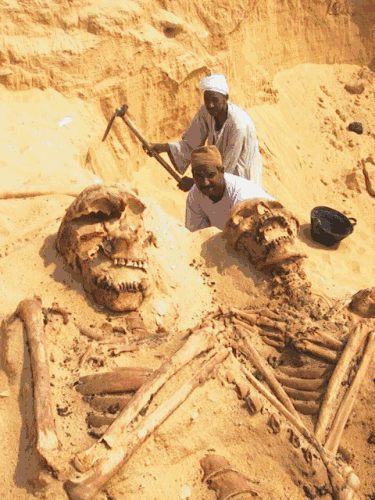Giant Human Bones: Truth or Tale

The mystery surrounding reports of “giant skeletons” has always intrigued and fascinated me. Specifically, how it seemed to be a common ocurrence that human-like bone remains, often of giant proportions, were known for popping up everywhere in the mid-to-late 1800s, as featured in reports like these:
- During an 1879 excavation of an Indian mound near Brewersville, Indiana, a nine-foot eight inch skeleton was found buried within.
- Around the same time, George W. Hill, M.D., also unearthed a skeleton said to be “of unusual size” while excavating a mound in Ashland County, Ohio.
- In 1880, American Antiquarian, volume three, reported that a Doctor Everhart allegedly found another large skeleton “reported to have been of enormous dimensions” in a strange clay coffin along with a sandstone slab marked with unidentified hieroglyphics near Zanesville Ohio.
- In 1881 in Medina County, Ohio, a succession of nine bodies were found below the cellar of a house, buried as though the corpses had been “dumped into a ditch.” Albert Harris, one of the residents, was twenty years old at the time of the grave’s discovery, and removing one of the large skeletons, said that he could literally fit the piece over his entire head and allow it to rest on his shoulders like a large helmet, even while wearing a cap underneath!
Still, we’ve all heard of how even well known authors of the era, including Mark Twain, contributed to the telling of “whoppers” in their day; that is, many writers who got their feet wet as newspaper writers for dailies would occasionally cook up tall tales when local news just wasn’t doing it (see a great example of this here). Eventually, I decided to try and find out if there might be any reports that could be verified with more certainty, and after some digging around in public domain archives, I found a couple.
In their 1894 report to the secretary of the Smithsonian Institute, Cyrus Thomas and Thomas Powell of the Bureau of Ethnology wrote of several discoveries where large human skeletal remains were found, the first ocurring in Roane County, Tennessee:
“Underneath the layer of shells the earth was very dark and appeared to be mixed with vegetable mold to the depth of 1 foot. At the bottom of this, resting on the original surface of the ground, was a very large skeleton lying horizontally at full length. Although very soft, the bones were sufficiently distinct to allow of careful measurement before attempting to remove them. The length from the base of the skull to the bones of the toes was found to be 7 feet 3 inches. It is probable, therefore, that this individual when living was fully 7½ feet high.”
And yet another instance, this time in presumed Indian burial mounds at Dunlieth, Illinois:
“Near the original surface, 10 or 12 feet from the center, on the lower side, lying at full length on its back, was one of the largest skeletons discovered by the Bureau agents, the length as proved by actual measurement being between 7 and 8 feet. It was clearly traceable, but crumbled to pieces immediately after removal from the hard earth in which it was encased….”
Indeed, it seems that the Smithsonian at one time reported oddities like these which they uncovered, especially during the “giant boom” of the late nineteenth century. Still, I can’t help but ask; if these kinds of discoveries were ever at all commonplace, why aren’t skeletons and other anomalies like this found more frequently in modern times… or are they?
During an email exchange I had last year with my good friend and mentor, Brad Steiger, we began discussing a few similar reports which he had included in his book Worlds Before Our Own, where a few such skeletons were said to exist in private museums. ”After the book was published, I learned of even more and included photos of them in my lectures,” he told me. ”Soon, individuals beseeched me to cease; the private museums were mysteriously suffering unexplained fires.” One is left to ask; what about anomalous relics of this (or any) sort could be so worthy of censorship on such a level?
Further complicating the mystery of missing giant bones is the following exerpt from an article I wrote which included the inquiries of the late zoologist Ivan T. Sanderson, best known for his interest in the legends regarding America’s Bigfoot and the Abominable Snowmen alleged to reside in the Himalayas:
“Sometime in the 1960s, Sanderson wrote about an odd letter he received regarding an engineer who, during World War II, had been stationed on the Aleutian island of Shemya. While building an airstrip, the bulldozing of a group of hills in the area led the engineer and his crew to unearth several sedimentary layers of human remains. They noted the extraordinary length of the crania and leg bones at the site, having apparently belonged to people of gigantic proportions. The skulls were said to have measured up to 24 inches from base to crown, far greater than the length of an average human skull. Also of interest was that each was said to have been trepanned, the strange process of drilling or cutting a hole and removing a top center portion of the skull, thought by some ancient cultures to enable a variety of alleged “benefits”, including psychic abilities, etc. Sanderson actively began to search for more proof of this incident, and later was able to contact another member of the unit who also confirmed the bizarre story. By all accounts, the remains were said to have been gathered by the Smithsonian Institution, but no record of where they were taken was ever issued. Sanderson seemed convinced that the institute did indeed retrieve them however, going so far as to ask ‘is it that these people cannot face rewriting all the textbooks?’


Comments
Post a Comment